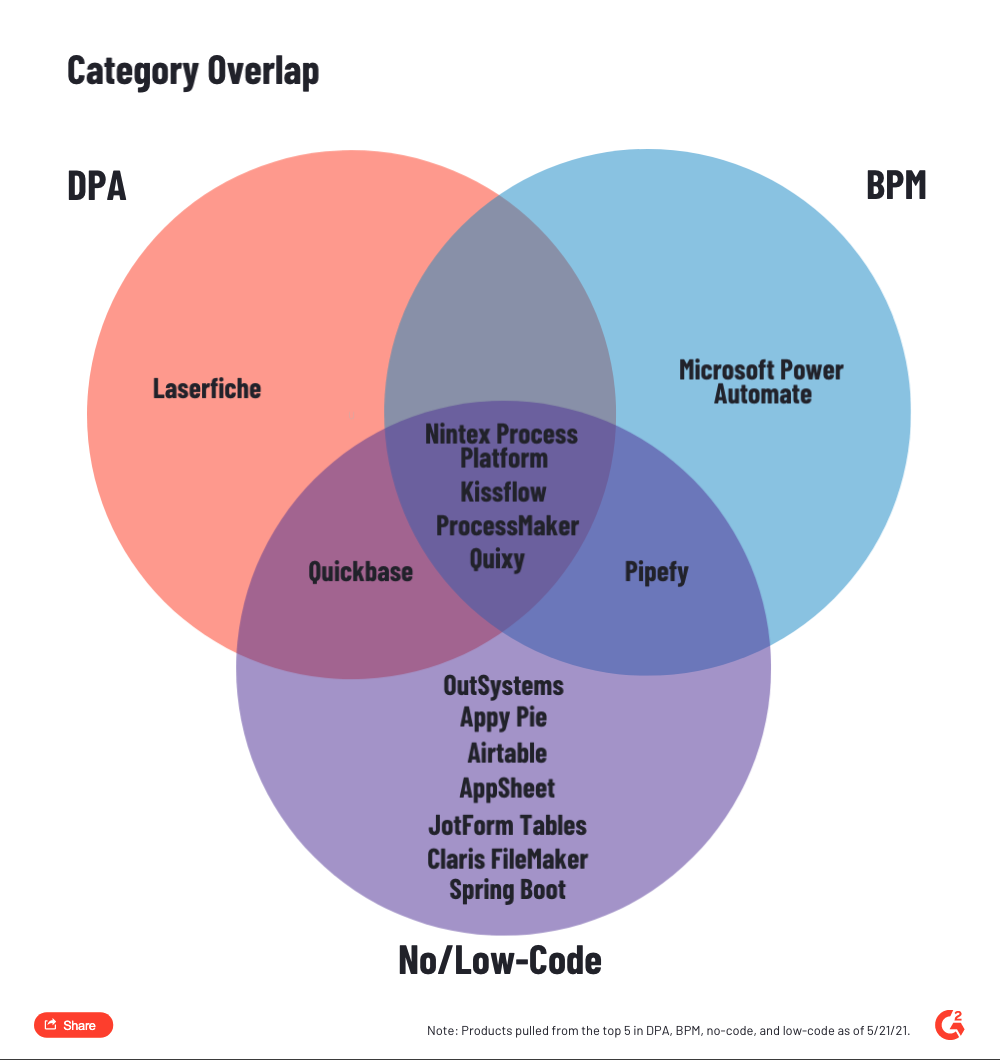It’s been over six months since G2 published its 2021 digital trends series. That means more than half a year ago, my fellow analysts and I put our most overconfident hats on and called some shots for our respective B2B software markets.
Among my predictions were some hype around code automation and WebOps platforms, and a strong suspicion that no-code and low-code development platforms would converge with the process automation space (a trend that was already starting, which does tend to make divination a bit easier).
| Read More: 2021 Trends in Software Development → |
Now, I’ll take a closer look at the no- and low-code space as it relates to process automation. Has the so-called convergence continued? What might be the driving factors at play? G2 data will paint a clearer picture of this shifting market space towards low-code process building as opposed to solution building.
Visualizing the low-code and process automation convergence
Back in December 2020, I mentioned that 5 of the top 10 business process management (BPM) software products on G2 (based on reviews gathered from our user community and data aggregated from online sources and social networks) were also categorized as either no-code or low-code development platforms. That figure has since increased to 9 of the top 10 BPM products at the time of writing this, only six months later. BPM products are increasingly positioning themselves in the no-code and low-code space and vice versa, which presents a much different picture than the historic view of low-code tools as pure application builders.
Speaking of pictures, here’s one I made to give a better idea of the convergence that’s happening in these spaces. This maps the overlapping categorization for the top five products in each of no-code and low-code development platforms, BPM, and digital process automation (DPA) software. No, you don’t have to hang it on the fridge if you don’t want to.

While a significant portion of DPA and BPM products are moving into the low-code space, that push appears to be mostly a one-way trend. A good deal of products in the no-code and low-code market remain focused on application building. This leaves us with two dominant and distinct flavors of low-code tools—those that solve process automation and those that build enterprise applications.
For software buyers, that means G2’s No-Code and Low-Code Development Platforms categories have plenty of new tenants with different use cases. So how are we ensuring that buyers find the tools they need?
Luckily, G2’s Low-Code Development Platforms GridⓇ includes attributes for the different use cases these software tools meet. These filters allow buyers to change which products are displayed on the G2 GridⓇ or in the product list based on the selection. This helps paint a clearer picture within categories that are becoming broader in scope, which low-code development platform certainly is.
It can be difficult to say for sure what’s causing so many process automation solutions to position themselves as low-code process builders. One major factor has been the abrupt and necessary shift to remote work many companies have made over the past year. Suddenly, all sorts of different businesses needed collaborative process automation tools to make virtual work environments possible. Digital transformation was no longer optional.
Viable remote work setups have become crucial to many companies’ continued survival, let alone competitive growth. That means for a lot of software buyers, finding the right process automation tool means finding a tool that fits their business model as effectively as possible. That’s what makes no-code and low-code functionality such a killer feature for these tools. Businesses need to be able to customize their process automation solution easily, and with as much control as possible. Buyers need the ability to build their own digital transformation solution quickly and effectively.
Beyond the overwhelming influence of changes related to the COVID-19 pandemic, process automation vendors’ extension into the low-code space was likely to happen anyway. The problems being solved by low-code platforms and process automation tools are similar—companies using them want to be more efficient, have a more competitive turnaround, and allow their employees to focus on tasks that represent the greatest value adds for the business. In the low-code world, that means allowing users to build enterprise solutions with simple inputs requiring fewer and fewer lines of code.
Meanwhile, process automation software solves these problems by removing more and more instances of human input throughout a given business process. Allowing users to have even greater power in shaping these automated processes through low-code building seems a natural evolution of such offerings.
| Related: Low-Code Development Platforms: Understanding Personas Amid Popularity Surge → |
It’s all coming together
Keep an eye on G2’s low-code and process automation spaces as they continue to intertwine. In my view, we will see these solutions continue to add functionality in pursuit of becoming one-stop-shop platforms for any company’s digital transformation needs. Eventually, these platforms will form the backbone for businesses that want competitive go-to-market strategies, effortless collaboration on remote work environments, and powerful yet efficient product development cycles.
| Read More: How Low-Code Platforms Can Help Shape Your Digital Workplace → |
¿Quieres aprender más sobre Software de Gestión de Procesos Empresariales? Explora los productos de Gestión de Procesos de Negocio.

Adam Crivello
Adam is a research analyst focused on dev software. He started at G2 in July 2019 and leverages his background in comedy writing and coding to provide engaging, informative research content while building his software expertise. In his free time he enjoys cooking, playing video games, writing and performing comedy, and avoiding sports talk.
